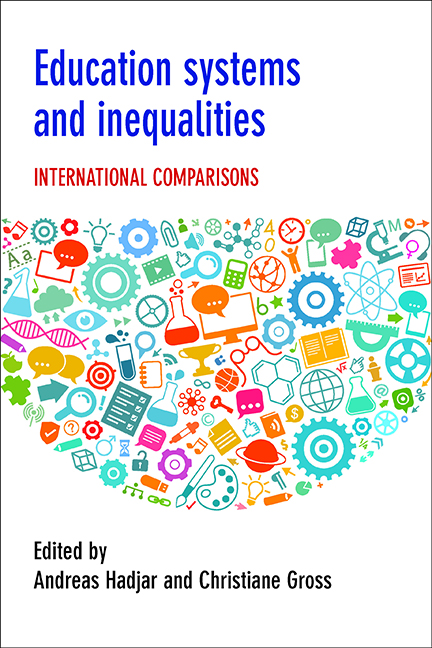Book contents
- Frontmatter
- Contents
- List of tables and figures
- Notes on contributors
- Acknowledgements
- Introduction: education systems and inequalities
- one Theorising the impact of education systems on inequalities
- two Comparing education policies in a globalising world: methodological reflections
- three Education systems and intersectionality
- four Measuring educational institutional diversity: tracking, vocational orientation and standardisation
- five Sorting and (much) more: prior ability, school effects and the impact of ability tracking on educational inequalities in achievement
- six Data analysis techniques to model the effects of education systems on educational inequalities
- seven Education systems and inequality based on social origins: the impact of school expansion and design
- eight Education systems and gender inequalities in educational attainment
- nine Tracking, school entrance requirements and the educational performance of migrant students
- ten From exclusion and segregation to inclusion? Dis/ability-based inequalities in the education systems of Germany and Nigeria
- eleven Education systems and meritocracy: social origin, educational and status attainment
- twelve Education systems and gender inequalities in educational returns
- thirteen Education systems and migrant-specific labour market returns
- fourteen Health returns on education and educational systems
- fifteen Good and bad education systems: is there an ideal?
- Conclusions and summary
- Index
one - Theorising the impact of education systems on inequalities
Published online by Cambridge University Press: 05 April 2022
- Frontmatter
- Contents
- List of tables and figures
- Notes on contributors
- Acknowledgements
- Introduction: education systems and inequalities
- one Theorising the impact of education systems on inequalities
- two Comparing education policies in a globalising world: methodological reflections
- three Education systems and intersectionality
- four Measuring educational institutional diversity: tracking, vocational orientation and standardisation
- five Sorting and (much) more: prior ability, school effects and the impact of ability tracking on educational inequalities in achievement
- six Data analysis techniques to model the effects of education systems on educational inequalities
- seven Education systems and inequality based on social origins: the impact of school expansion and design
- eight Education systems and gender inequalities in educational attainment
- nine Tracking, school entrance requirements and the educational performance of migrant students
- ten From exclusion and segregation to inclusion? Dis/ability-based inequalities in the education systems of Germany and Nigeria
- eleven Education systems and meritocracy: social origin, educational and status attainment
- twelve Education systems and gender inequalities in educational returns
- thirteen Education systems and migrant-specific labour market returns
- fourteen Health returns on education and educational systems
- fifteen Good and bad education systems: is there an ideal?
- Conclusions and summary
- Index
Summary
Introduction
Recent research has shown the strong impact that the institutional settings of educational systems have on educational inequalities and, via education, on inequalities in manifold life chances (labour market chances, income, health, political participation and so on). The main characteristics that have been determined as driving forces are stratification (tracking), standardisation and vocational specificity. Tracking in terms of a stratified course system accounting for student talents and abilities in each subject is discussed regarding the student age at the beginning of different school tracks (times of selection) and with regard to within-school and between-school tracking. Stratification (also known as external differentiation) refers to the selection of students into distinct educational pathways (schools or classrooms) with differing aspiration levels. Standardisation is linked to issues such as school equipment, the level of school autonomy and the existence of central examinations. Vocational specificity is related to the question of how the education system and its institutions are linked to the occupational system and the labour market. These characteristics of education systems may vary between countries, but also between regions within countries, or even between schools. They may serve as clues as to how heterogeneity and diversity is managed in the daily school routine. Often they reflect a nationwide strategy that has a variety of effects, from tackling to tolerating social inequalities, or even fostering them. So the conceptual and empirical challenge is to separate the effect of country attributes, such as income inequality or welfare state regime, from effects of characteristics of education systems.
When we speak of an education system, we refer to institutional settings in which processes of education are embedded. Such institutional settings include schooling systems at different levels (pre-schooling, primary and secondary schooling), but also vocational training and higher education systems. Crucial to the analysis of inequalities is the structure of the education system, in particular the available education institutions, how they can be accessed, how people can transit from one to another educational stage, and how they can move between parallel institutions (for example, upper secondary general versus upper secondary vocational education). Institutional settings thus also structure educational pathways and imply ‘normal’ pathways.
- Type
- Chapter
- Information
- Education Systems and InequalitiesInternational Comparisons, pp. 11 - 32Publisher: Bristol University PressPrint publication year: 2016



